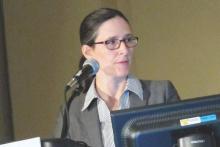BOSTON – Extreme breast density on mammography in women with breast cancer is a strong independent risk factor for in situ or invasive cancer in the contralateral breast, investigators in two studies say.
Among 7,684 women with breast cancer followed by the Breast Cancer Surveillance Consortium, those with extremely dense breasts according to Breast Imaging Reporting and Data System (BI-RADS) criteria had a more than twofold risk for cancer in the contralateral breast, compared with women with fatty breasts, reported Dr. Maureen O’Donnell, a surgeon at Johns Hopkins Hospital in Baltimore.
“Mammographic density may identify women whose lifetime contralateral breast cancer risk is high enough to warrant enhanced surveillance with MRI, and may contribute to individualized contralateral breast cancer risk estimations, and help guide surgical decision making,” she said at the annual Society of Surgical Oncology Cancer Symposium.
The findings of Dr. O’Donnell’s study were supported by a separate, nested case-control study in 680 patients showing that patients with extremely dense or heterogeneously dense breasts had a nearly twofold risk for developing a contralateral breast cancer, compared with those with fatty breasts.
“The hormonal receptor status of the contralateral breast cancer was independent of breast density,” noted Dr. Akshara Raghavendra of the University of Texas MD Anderson Cancer Center in Houston.
Breast density is a known risk factor for primary breast cancer. Breasts with greater than 75% density are associated with a fivefold greater risk for cancers than breasts with no dense tissues, according to the Boyd Classification of Breast Density.
To assess whether mammographic density modifies the risk of contralateral in situ or invasive breast cancer after an initial diagnosis, Dr. O’Donnell and colleagues looked at records on 7,684 patients with a screening mammography and diagnosis of breast cancer from 1998 through 2009. In this group, invasive cancers were diagnosed in 70% of patients, ductal carcinoma in situ (DCIS) in 24%, and mixed DCIS/invasive in 6%.
Of these patients, 1,921 developed cancer in the contralateral breast, with a median time from the diagnosis of the primary cancer of 4.8 years. The distribution of contralateral cancers was similar to that of the primary cancers, with more than two-thirds of patients having invasive tumors.
The patients with contralateral cancers were retrospectively matched with three controls each for year of diagnosis of the primary cancer, race, and follow-up time.
In univariate analysis, factors significantly associated with increased risk for contralateral breast cancer were heterogeneous mammographic density (odds ratio, 1.77; P = .016), extreme density (OR, 2.13; P = .004), age 30-40 at diagnosis (OR, 1.38; P = .005), age younger than 30 at diagnosis (OR, 2.27; P = .009), and estrogen receptor–negative status (OR, 1.23; P = .006).
In multivariate analysis controlling for age and antiestrogen therapy, factors associated with increased risk, compared with fatty breasts, were heterogeneous density (OR, 1.78; P = .015), and extreme density (OR, 2.34; P = .004). Women with breasts with scattered fibroglandular density had a borderline but nonsignificantly increased risk.
In the second study, Dr. Raghavendra and colleagues performed a retrospective nested case-control study in which every patient with breast cancer was matched with two controls by year of diagnosis of the primary cancer and by hormone receptor status of the primary tumor.
In multivariate analysis controlling for body mass index, tumor histology, chemotherapy, endocrine therapy, and radiation, they saw that, compared with women with predominantly fatty breasts, women with dense breasts (extreme and heterogeneous densities combined) had a nearly twofold increased risk for contralateral breast cancer (OR, 1.80; P = .03).
Because hormonal therapy is known to influence breast density, the investigators examined the relationship between hormone receptor subtypes of contralateral breast cancers and density, and found that there was no difference between hormone receptor negative or positive cancers as a function of density.
The study by Dr. O’Donnell and her colleagues was supported by the Breast Cancer Surveillance Consortium and by a grant from the National Cancer Institute. Dr. Raghavendra did not disclose a funding source. Both investigators reported having no conflicts of interest.



